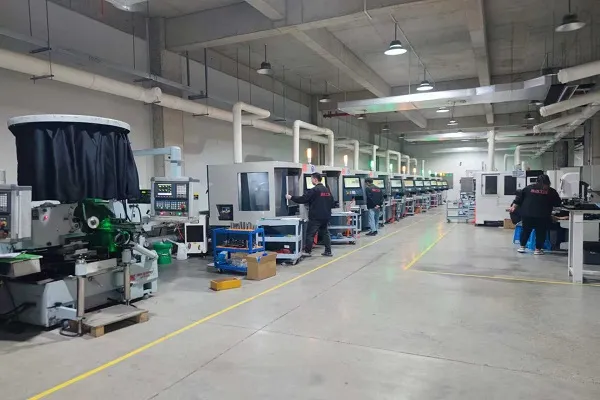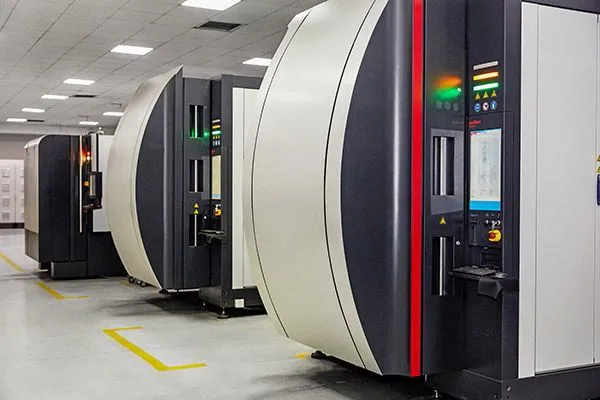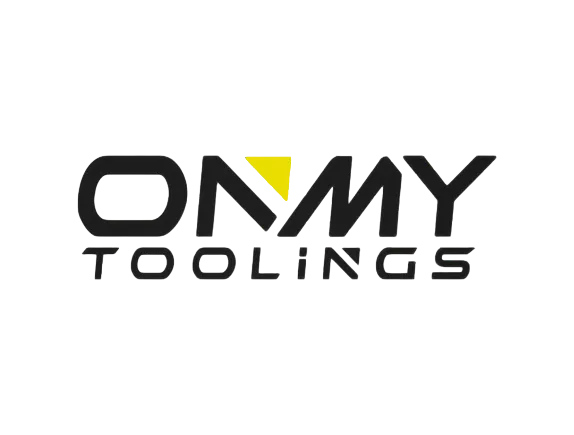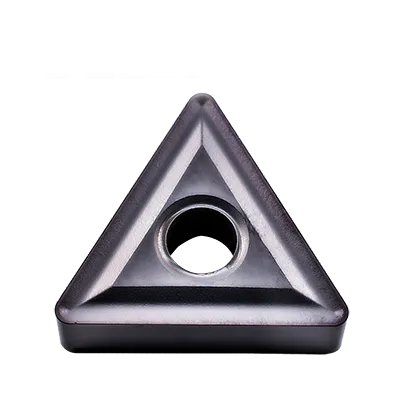
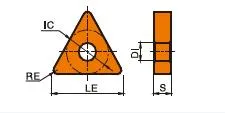
TNMG車刀
TNMG插入角度:60°三角形碳化物插入物; 0°負耙子插入和雙面與芯片破壞者;
斷路器應用:粗加工,半插圖加工,完成加工;
TNMG插入9.525mm/12.7mm的插入圓圈(IC),厚度為4.76mm,轉角(鼻子)半徑為0.4mm/0.8mm/0.8mm/1.2mm;
匹配TNMG插入工具支架:PTFNR/L,PTTNR/L,PTGNR/L,MTGNR/L,MTJNR/L,MTFNR/L;
TNMG插入規格:(ISO)TNMG1604插入/TNMG2204插入/(ANSI)TNMG322插入/TNMG331插入/TNMG332插入/tnmg431 insert/tnmg431 insert/tnmg432 insert;
TNMG插入物可以通過組合不同的等級來處理多個操作;
維珍材料:100%;
tnmg插入含義
使用此T形TNMG碳化物插件來升級加工!
其負角度設計可確保高效,穩定的性能。
靈活的尺寸意味著您非常適合自己的工具和項目需求。
較大的插入物提供了更大的穩定性。
與老式的焊接插件相比,加工速度的增強速度可提高4倍,加上無與倫比的耐磨性,溫度耐受性,抗腐蝕能,剛度,剛度,節省成本,能源效率和較長的工作壽命。
TNMG插入規範
TNMG名稱
- 電話: 三角形
- 紐: 負耙角(對於更強的尖端)
- 中號: 公差類(指示精度)
- 克: 芯片破壞者類型(可以因製造商而異)
常見的TNMG維度
TNMG與其他插入類型一樣,使用數字來指示大小:
TNMG 33X: (最常見)
- 銘文圓(IC):0.375″ (3/8″)
- 厚度:0.125″ (1/8″)
- x表示鼻子半徑(例如1 = 1/32″,2 = 1/16″)
TNMG 43X:
- 銘文圓(IC):0.5″ (1/2″)
- 厚度:0.188″ (3/16″)
- x表示鼻子半徑
TNMG插入物的主要特徵
- 負耙角: 提供耐用的尖端,非常適合更堅固的材料和中斷的切割。
- 60°包括角度: 三角形插入物的標準,用於多功能轉彎操作。
- 廣泛的芯片芯片: TNMG插入物通常具有復雜的芯片設計,嚴重影響了芯片形成和對特定材料和應用的控制。
- 塗料: 通常用錫,TICN,Altin等材料塗層,以延長工具壽命和耐磨性。
tnmg插入支架

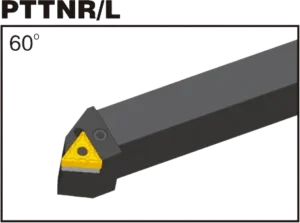


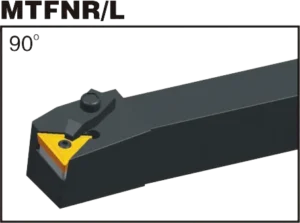
mtjnr/l

碳化物TNMG插入尺寸(ISO和ANSI)
| TNMG插入尺寸 | ||||
|---|---|---|---|---|
| ANSI 名稱 | ISO 名稱 | 內切圓 (IC) | 厚度 | 轉角半徑 |
| TNMG 321 | TNMG 1604 | 1/2" (12.7mm) | 1/8" (3.18mm) | 1/32" (0.8mm) |
| TNMG 322 | TNMG 1604 | 1/2" (12.7mm) | 3/16" (4.76mm) | 1/32" (0.8mm) |
| TNMG 431 | TNMG 2204 | 3/4" (19.05mm) | 1/8" (3.18mm) | 1/32" (0.8mm) |
| TNMG 432 | TNMG 2204 | 3/4" (19.05mm) | 3/16" (4.76mm) | 1/32" (0.8mm) |
| TNMG 433 | TNMG 2206 | 3/4" (19.05mm) | 1/4" (6.35mm) | 1/32" (0.8mm) |
| TNMG 643 | TNMG 32.51 | 1 1/4" (31.75mm) | 1/4" (6.35mm) | 1/32" (0.8mm) |
示例:TNMG 432
- 電話: 三角形
- 紐: 負耙角
- 中號: 公差課
- 克: 60°包括角度
- 4: 刻有0.5的圓圈″ (1/2″)
- 3: 厚度為0.188″ (3/16″)
- 2: 刀尖半徑為 0.0625″ (1/16″) - 有益於通用工作
經常問的問題
絕對地!這是TNMG和CNMG插入物之間的關鍵差異的細分,包括它們的形狀,應用和優勢:
形狀
TNMG:具有60度的角度的三角形插入物。提供三個切割邊緣。
CNMG:帶有80度的鑽石形插入物(包括角度)。提供四個切割邊緣。
尖端強度
TNMG:三角形形狀的三個切割邊緣具有良好的多功能性,但與CNMG相比,穩健性略低。
CNMG:鑽石形狀上的四個切割邊緣提供了出色的強度,非常適合重加工操作。
可訪問性
CNMG結合了在一種工具中轉動和麵對的靈活性,以及一種能夠進行大量切割和濫用的堅固工具。如果您正在做工作店工作,或者在同一工具中進行粗略的轉彎和麵對面,那麼CNMG是必經之路。另外,不要忘記,您可以使用100*角來進行不需要您進入角落的操作。以削減為例。
TNMG提供了兩個額外的角落,以及口袋中的寬敞軸承表面,以多功能性為代價。如果您可以優化使用該工具專門用於面向或轉彎的工具路徑,我認為這些是要走的方式。
這是有關如何識別TNMG插入物的大小的分步指南:
1。了解TNMG代碼:
- TNMG: 這部分是標準的,並告訴您這是一個帶有負耙角以及某種形式的孔和芯片設計的三角形插入物。
- 以下數字: 之後的數字 “TNMG” 是確定尺寸的關鍵。
2。編譯數字代碼:
讓我們使用常見的示例TNMG 332:
- 第一個數字(3): 指示16英寸的尖端長度(3/16″)。
- 第二個數字(3): 表示16英寸(3/16)中插入物的厚度″)。
- 最終數字(2): 鼻半徑代碼。一個常見的規模是:
- 1 = 0.0312″ (1/32″)
- 2 = 0.0625″ (1/16″)
3。知道您的單位:
- ANSI: 通常使用帝國測量值(英寸)進行TNMG尺寸。
- ISO: 可以使用度量測量值(毫米)。示例:TNMG 160408表示一個12.7毫米的圓圈和4.76mm的厚度。
4。諮詢製造商資源:
有關最準確,最完整的信息,請參閱您的特定TNMG插入文檔。製造商和供應商提供詳細的尺寸圖表和規格。以下是:
- 獲取完整的代碼: 在插入物或包裝上找到完整的代碼。
- 在線搜索: 使用完整的代碼搜索製造商或供應商的網站/目錄。
附加說明:
- 鼻子半徑: 這會影響表面飾面 - 較小的半徑更適合完成。
- Chipbreaker設計: 'g’ 在TNMG代碼中,指示了芯片的樣式,並且是芯片形成和控制的關鍵因素。最好諮詢製造商文檔,以了解Chipbreaker的理想應用程序。
讓我知道您的TNMG插入物的特定代碼,我可以提供確切的尺寸!
以下是識別TNMG插入物的刻有圓圈(IC)的方法:
1。了解TNMG代碼:
TNMG插入物的刻有圓圈是可以在插入物三角形內繪製的最大圓的直徑。這個核心維度決定了它可以採取的幅度。
2。編譯數字代碼:
TNMG代碼中指示IC的主要方式有兩種:
ANSI(帝國單位):
將大小代碼的第一個數字除以8。
示例:TNMG 332 – 3/8 = 0.375″ 這是銘文的圓圈。
ISO(公制單位):
該IC通常直接在代碼中給出。
示例:TNMG 160408 – 16表示16mm的銘文圓。
3。製造商的變化:
- 一些製造商可能會稍微修改指標大小的TNMG插入物的編碼。
- 始終請參閱製造商或供應商的文檔,以確認確切的IC。
如何查找銘文的圓圈信息
- 完整名稱: 在插入物或包裝上找到完整的TNMG代碼,包括大小。
- 製造商/供應商資源: 搜索製造商或供應商的網站以獲取其TNMG目錄或尺寸圖表。
重要說明: 請記住,銘文圓只是大小的一部分。 TNMG代碼中的其他數字定義了厚度和鼻腔半徑,也需要理解以進行適當的插入選擇。
讓我知道您插入的特定TNMG代碼,我會告訴您它的確切銘文圓圈!
TNMG插入物是用於將各種材料加工的車床操作的一種常見切割工具插入物。這是您需要了解的:
主要特點
- 形狀: 三角形,帶有三個可用的切割邊緣。
- 負耙角: 切割臉與尖端邊緣向後傾斜。這提供了強大,耐用的邊緣,非常適合更堅固的材料和中斷的切割。
- 60°包括角度: 三角形插入物上的標準角度使TNMG多功能用於各種轉彎應用。
- 斷屑槽: TNMG插入物通常在一個或兩側具有復雜的芯片破解器幾何形狀。這些芯片破壞者極大地影響了芯片形成,芯片流和切割性能。
- 塗料: 插入物經常塗有錫,阿爾汀和其他材料,以改善耐磨性和工具壽命。
應用領域
TNMG在這些領域插入Excel:
- 材料: 它們廣泛適用,尤其是由於其負耙角而用於鋼,鑄鐵和一些更硬的材料。
- 營運: TNMG根據插入物的特定鼻子半徑和碎屑設計,處理粗糙,半固定和通用轉折任務。
了解TNMG代碼
TNMG名稱中的字母和數字提供了關鍵的細節:
- 電話: 三角形
- 紐: 負耙角
- 中號: 公差類(指製造精度)
- 克: 表示特定的孔和斷屑槽設計(因製造商而異)
- 數字:
- 通常,第一個數字代表16英寸的尖端長度(或直接以毫米的ISO代碼為單位的圓圈)。
- 第二個數字表示16英寸的厚度。
- 最後一個數字通常表示刀尖半徑(越小意味著越鋒利)。
示例:TNMG 160408(ISO)
- 三角形負耙插入。
- 刻有12.7毫米的圓圈。
- 厚度為4.76mm
- 特定的斷屑槽/孔設計。
選擇正確的插入
根據以下方式選擇一個TNMG插入物
- 工件材料
- 轉彎操作類型 (粗糙與整理)
- 所需的表面飾面
- 需要特定的芯片控制
讓我知道您是否需要幫助解釋特定的TNMG代碼或考慮特定的加工任務,我可以建議使用合適的插入選項!
The Science Behind Carbide Inserts: How They're Made and Why They're So Strong
硬質合金刀片是目前最通用、最耐用的切削工具之一。但它們是如何製作的呢?是什麼讓他們如此強大?在本影片中,我們將探索硬質合金刀片背後的科學,從碳化鎢的特性到製造流程。
我們的生產能力

